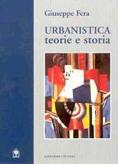fabrication sustainability renaissance social housing representation outskirts & suburbs information technology globalization agriculture knowledge premio letteratura urbanistica simulation urban form transport & logistics premio tesi di laurea dottorati local development tools and techniques mobility large scale plans & projects immigration demography social capital cities democrazia
Urbanistica - Teorie e Storia - Review
by Marina A. Arena
Urbanistica, teorie e storia is a textbook that drives the students trough the evolution of modern town planning's philosophy, especially in Europe and North America, starting from the second half of XIX century up to nowadays. The evolution of planning theories is at the same time related to the development of cities and to their social and economic context.
According to its author, the book stems from the need to review the key ideas that contributed to the birth and development of modern town planning or, in other words, from the need to "stop the ship" and think about the course that lead town and regional planning to assume the specific characters they have today. Therefore, the book prompts its readers to come out of the daily chronicle of events and look back at History, the best way, for the author, to understand the recent evolution of planning. The first step is to point out the paths along which the development of European and North American town planning has moved; then it becomes possible to identify the elements of continuity or, in contrast, the ruptures in both theories and practices achieved in the last two centuries. The belief that History provides an order across long distances, carries the author to look at what Braudel defines "Deep History"; as a consequence, in the attempt of rebuilding the genetic codes of modern town planning, Fera appeals to most ancient events.
The book is explicit in its aim to be a "useful book", an aim deeply set in its origin as lecture notes for the Town planning theories class, taught by the author for the last ten years at the University of Reggio Calabria. Fera remains a teacher at heart also as he writes. In conceiving the book as an hypertext, he imagines to be in a classroom and to be asked questions by the students, with whom he opens "dialogue windows" that offer a permanent knowledge support to the book reader.
Fera has produced his book in the same way he works in the classroom, showing his concern to be understood by the students, both in terms of working methods and communication forms. The need to be clear and plain has led to a product of high quality that gives to the younger students the basic tools on which to build their further planning studies and to the older ones the opportunity to check their knowledge in the field and eventually review and update some old ideas about the role and the basic principles of modern town planning.
For these reasons the book is a sort of "work tool", useful to give an answer, (as the author himself states in the introduction) "to the demand for education in the field of regional and town planning, and, in other words, to the demand for a textbook able to help the students in their studies".
The growing demand for planning education coincides with the conclusion of a long period of critical evaluation of Modern Town planning, along which many traditional beliefs have been shaken and new knowledge has enriched the heritage of goals, tools and the statute of the planning discipline. At the same time, as a consequence of this cultural enrichment, the demand for and the role of professional town planners have also increased. The book tries to catch, trough the study of theories, plans and urban form, the weaving and the overlap of different town planning events, seen as the sum of architectural, economical, political and symbolic aspects.
Bernardo di Charters said that "we are as dwarfs sitting on a giant's shoulders", and these giants, the ones selected by Fera to meet us trough the town planning evolution are Olmsted, Geddes, Mumford, Lynch, etc; climbing on their shoulders the author can give a good look at the horizon of planning. For his scientific ad educational purposes the author uses different tools: the windows fit inside the different chapters, to highlight the different cultural and historical contexts; the Appendixes, at the end of the different chapters, are used to look into the legislative aspects and the planning experiences; the References and the index of authors are provided to give a broader view of the discipline.
At the core of the book are the Theories (ideas, methods, and concepts) that contributed to the construction of Modern Town planning. The book starts from the half of XIX Century, with the birth of Modern town planning as an effort to treat the diseases of the industrial city; it continues with the making of the disciplinary constitution through the first part of XX Century; to eventually reach the newest paradigms added to the traditional topics of town planning: sustainable development, environmental conservation, interactive planning and participation.
The last part of the book concerns the theories of urban form, focusing on some specific aspects: the conflict between Modernism and Historicism, the different role of function and sense in the urban form, the "lived" urban space, the concentration and/or diffusion of housing in metropolitan areas.
The book opens with a first chapter "From town design to town planning" and closes with the last chapter "From town planning to town design", a sort of suggestion by the author that History and life never have a linear development.
This is a review for:
[Book] Urbanistica - Teorie e Storia
by Giuseppe Fera




Planum
The Journal of Urbanism
ISSN 1723-0993
owned by
Istituto Nazionale di Urbanistica
published by
Planum Association
ISSN 1723-0993 | Registered at Court of Rome 4/12/2001, num. 514/2001
Web site realized by ChannelWeb & Planum Association | Powered by BEdita 3

